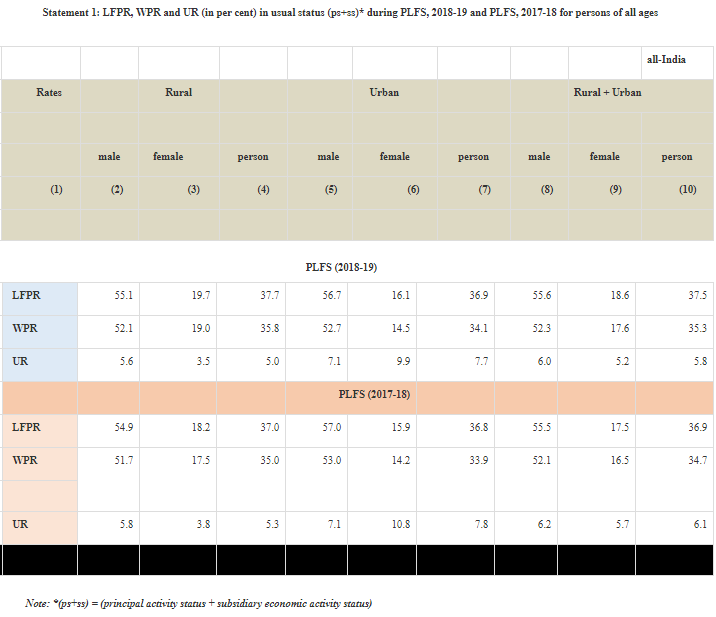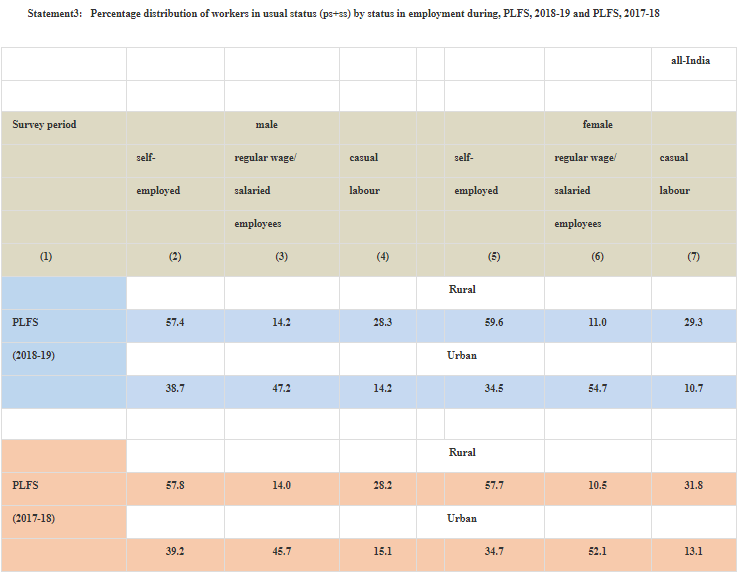Focus: GS-III Indian Economy
Why in news?
- Periodic Labour Force Survey (PLFS) – Annual Report July, 2018 – June, 2019 and the Quarterly Report on PLFS, ending June 2019, is released by the National Statistical Office (NSO) on 4th June 2020.
- This is the second Annual Report being brought out by NSO on the basis of Periodic Labour Force Survey conducted during July 2018-June 2019.
Key Findings of PLFS, Annual Report (2018- 2019)


Key Points: Interpretation of the Data (Important)
- India’s unemployment rate improved from the 45-year high of 6.1% in 2017-18 to 5.8% in 2018-19.
- The labour force participation rate also improved marginally, from 36.9% in 2017-18 to 37.5% in 2018-19.
- Women’s unemployment fell from 5.7% to 5.2% – by 0.5%.
- Male unemployment only fell from 6.2% to 6%. – by 0.2% only.
- Urban unemployment is still high at 7.7% dropping just 0.1% from 7.8% in 2017-18.
- Rural unemployment fell from 5.3% to 5%.
- 22% of women in India above 15 were part of the labour force, as against 71.2% men between July 2017 and June 2018.
- Unemployment rate among Schedule Castes (SC) and Schedule Tribes (ST) has gone up during Fiscal Year 2018-19. This is despite overall rate dropping to 5.8 per cent from 6.1 per cent.
- Youth in the age bracket of 15-29 years and educated persons have unemployment rate in the double digits with 17.3 per cent and 11 per cent respectively.
- The worst affected are urban youths with 20.7 per cent unemployment and among urban females it is 25.7 per cent.
Key Employment and Unemployment Indicators
The Periodic Labour Force Survey (PLFS) gives estimates of Key employment and unemployment Indicators like the Labour Force Participation Rates (LFPR), Worker Population Ratio (WPR), Unemployment Rate (UR), etc. These indicators are defined as follows:
Labour Force Participation Rate (LFPR): LFPR is defined as the percentage of persons in labour force (i.e. working or seeking or available for work) in the population.
Worker Population Ratio (WPR): WPR is defined as the percentage of employed persons in the population.
Unemployment Rate (UR): UR is defined as the percentage of persons unemployed among the persons in the labour force.
Activity Status- Usual Status: The activity status of a person is determined on the basis of the activities pursued by the person during the specified reference period. When the activity status is determined on the basis of the reference period of last 365 days preceding the date of survey, it is known as the usual activity status of the person.
Activity Status- Current Weekly Status (CWS): The activity status determined on the basis of a reference period of last 7 days preceding the date of survey is known as the current weekly status (CWS) of the person.
Periodic Labour Force Survey (PLFS)
- National Statistical Office (NSO) launched Periodic Labour Force Survey (PLFS) on April 2017.
- The objective of PLFS is primarily twofold:
- to estimate the key employment and unemployment indicators (viz. Worker Population Ratio, Labour Force Participation Rate, Unemployment Rate) in the short time interval of three months for the urban areas only in the Current Weekly Status (CWS)
- to estimate employment and unemployment indicators in both usual status (ps+ss) and CWS in both rural and urban areas annually.
Sampling Design
- The sampling design remains the same as during 2017-18, that is, a rotational panel sampling design in urban areas. In this rotational panel scheme, each selected household in urban areas is visited four times, in the beginning with First Visit schedule and thrice periodically later with a Revisit schedule.
- For rural areas, samples for a stratum/sub-stratum were drawn randomly in the form of two independent sub-samples.
- In view of these changed sampling designs, the PLFS estimates are not comparable with the results of Employment Unemployment Survey (EUS) of 2011-12 and earlier years.





